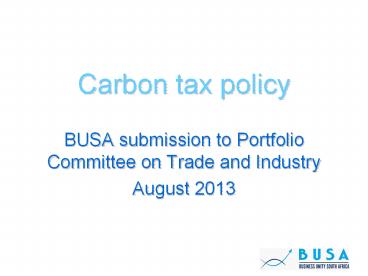Carbon%20tax%20policy - PowerPoint PPT Presentation
Title:
Carbon%20tax%20policy
Description:
... Domestic mitigation options are limited Economic impacts likely to be substantial Overarching business view Carbon price supported in pursuit of ... Metal . Other ... – PowerPoint PPT presentation
Number of Views:153
Avg rating:3.0/5.0
Title: Carbon%20tax%20policy
1
Carbon tax policy
- BUSA submission to Portfolio Committee on Trade
and Industry - August 2013
2
Overview
- South African business has already made
significant progress in emission reduction - Domestic mitigation options are limited
- Economic impacts likely to be substantial
3
Overarching business view
- Carbon price supported in pursuit of lower carbon
growth trajectory - Imperative to understand impact of any state
intervention - Carbon tax must be aligned with other mitigation
instruments - Need to operate in context of global climate
action - Proposed carbon tax is not only carbon price
4
Potential change in behaviour
- Change required reduce GHG emissions
- Potential at firm level limited by
- lack of choice in energy supply
- non availability of mitigation technology
- engineering constraints
- Structure of the economy energy intensive and
trade exposed - Shift to significantly lower carbon intensity not
possible concurrent with beneficiation objectives
5
- Current environment
- State of economy
- Mitigation
6
Manufacturing trends ( the dti, 2011)
7
Trade trends (the dti, 2011)
8
South African exports 2012
Energy intensive sectors (R438bn)
9
Trends in economic activity
10
Employment trends in manufacturing
11
Trends in energy intensity and electricity sent
out
12
SA electricity efficiency vs average real
electricity selling price
13
Selected electricity prices
14
Contribution of sources to the total energy
sector GHG emissions
15
Carbon price
- Paper does not recognise current and future
carbon pricing instruments - Carbon tax on motor vehicles
- Carbon price included in electricity price
- Levy on non renewable electricity generation
R35/ton - Premium of R116/ ton CO2 for renewable
electricity generation - Mitigation instruments being developed by DEA
will have an implementation cost which results in
a price for carbon - Biofuel levy
16
Availability of mitigation technology
- Technology to reduce GHG emissions resulting in
non energy process emissions is not available for
all processes - Examples
- nitric production nitrous oxide emissions have
been already been significantly reduced - Carbide and ammonia slight efficiency
improvements possible
17
Emission levels in the Chemical Industry, 2000
2010.
No technology
Technology
Technology
No technology
18
Desired emission reduction outcomes
- Mitigation analysis currently in progress
- Mitigation options are generally limited in
energy intensive sectors - Analysis will be used as basis for further
detailed sectoral and firm level work to develop
desired emission reduction outcomes - DEROs will be implemented through mandatory
mitigation plans - Energy efficiency targets will be implemented
through mandatory energy management plans
19
- Challenges with proposed carbon tax
- Impact
- Lack of policy alignment
20
Effect of tax on electricity price
Impact of carbon tax on electricity CPI
9
8 per annum
21
Electricity price weight in CPI basket
22
Illustrative effective carbon price
- First developing country with a carbon tax
- Premature given global
- negotiations
- More regions moving to trading schemes
- Effective carbon price higher than most other
jurisdictions
US per ton CO2
23
Electricity contribution to operating cost (
Megaflex tariff)
24
Alternative approaches
- Global agreement on mitigation
- Expected in 2015
- Implementation in 2020
- Adjust timing to ensure tax supports South
Africas commitment - Desired emission reduction outcomes
- Expected in 2014
- Adjust timing to base thresholds on DEROs
25
Alternative approaches (2)
- Simplify and clarify design
- Provide protection for trade exposure and energy
intensive sectors - Do not limit use of offsets
- Use desired emission reduction outcomes as basis
of thresholds - Align tax level with levels in competing
economies
26
Way forward
- Collaboration to find balanced approach































